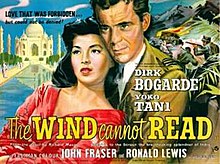|
The Wind Cannot Read
The Wind Cannot Read is a 1958 British drama film directed by Ralph Thomas and starring Dirk Bogarde, Yoko Tani, Ronald Lewis and John Fraser.[1] It was based on the 1946 novel by Richard Mason, who also wrote the screenplay. PlotThe film takes place in Burma and India during World War II. A British officer falls in love with his Japanese instructor at a military language school. They start a romance, but she is regarded as the enemy and is not accepted by his countrymen. They marry in secret and plan on spending his two weeks' leave together. When one of the other officers is injured, he is sent into the field as an interrogator. Later he is captured by the Japanese army when he is patrolling with a brigadier and an Indian driver in a Japanese-controlled zone. He escapes and returns to his own lines, only to discover that his wife is suffering from a brain tumour. Although the doctor initially gives her good odds of surviving, she dies after an operation. Cast
TitleThe film's title derives from a Japanese poem, quoted in Basil Chamberlain's 1907 book A Handbook of Colloquial Japanese as:[2]
The poem appears in the title sequence of the film translated as:
It is also printed in the front matter of the original novel,[3] and is on the tombstone of Mason, who died in 1997.[citation needed] ProductionIn 1955 David Lean agreed to film Richard Mason's novel The Wind Cannot Read, the story of a romance between a British officer and a self-exiled Japanese woman in India circa 1943, during World War II.[4] Originally Lean considered making the lead character a Canadian and offered the part to Glenn Ford.[5] Lean also offered the role to Kenneth More, who was unsure about whether the public would accept him in the part and turned it down. It was a decision More later regarded as "the greatest mistake I ever made professionally".[6] Lean had completed a script in collaboration with Mason and cast Keiko Kishi as the girl, but disagreed with Alexander Korda, who was to have produced the film and the project fell through.[7] Lean had already entered into discussions with Sam Spiegel, regarding a film version of Pierre Boulle's novel The Bridge on the River Kwai. After Korda's death in 1956, the rights to Mason's novel were sold to Rank Film Productions, who assigned the project to the team of Betty Box and Ralph Thomas.[8] Filming took place on location in India in early 1958, with Dirk Bogarde in the main role.[9][10] Ralph Thomas later said he thought Sir John Davis of Rank "very bravely" authorised location-filming in India "because he trusted David Lean's judgement that it was a splendid book. It was a real three-handkerchief picture, which I thoroughly enjoyed making, and Dirk was very good in it."[11] ReceptionBox officeThe film was one of the most popular at the British box office in 1958.[12][13] Kinematograph Weekly listed it as being "in the money" at the British box office in 1958.[14] Critical receptionThe Monthly Film Bulletin wrote: "This adaptation of Richard Mason's novel is what the trade describes as a 'woman's picture', in this case complete with exotic music and a cloying theme song. Its central love story is alternately coy, sentimental and pathetic, and the emotions of the audience are touched in such a way as to arouse sympathy, without becoming too painful for comfort. The war episodes, involving Japanese brutalities, are presumably intended for those in need of sterner stuff; at any rate, they fit rather uneasily into the monotonous, gentle pattern of the rest. Visually, the film benefits from its Indian locations: crowded bazaars, city streets and picturesque views of the Taj Mahal provide genuine, if predictable, local colour. Yoko Tani has a distinctive charm and plays with some feeling; Dirk Bogarde, though, seems over-reserved and uncomfortable, especially when confronted with pseudo-poetic dialogue."[15] AccoladesSongwriter Peter Hart received the 1958 Ivor Novello award for Best Song Musically and Lyrically for the title song, performed by Vera Lynn.[16] References
External links |
||||||||||||||||||||||||||||
